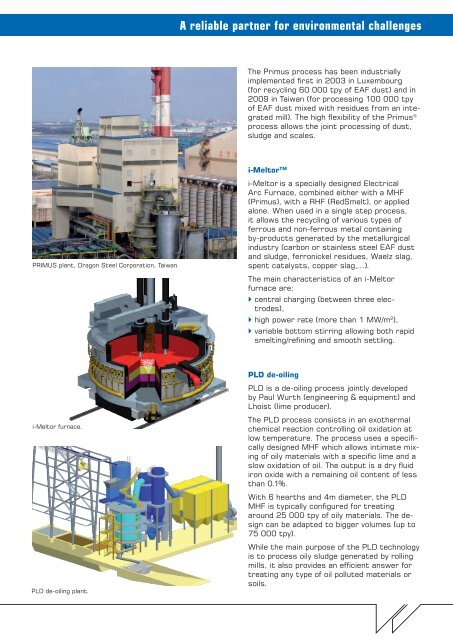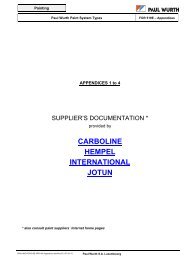Recycling Technologies RedSmelt - Paul Wurth
Recycling Technologies RedSmelt - Paul Wurth
Recycling Technologies RedSmelt - Paul Wurth
Create successful ePaper yourself
Turn your PDF publications into a flip-book with our unique Google optimized e-Paper software.
PRIMUS plant, Dragon Steel Corporation, Taiwan.<br />
i-Meltor furnace.<br />
PLD de-oiling plant.<br />
A reliable partner for environmental challenges<br />
The Primus process has been industrially<br />
implemented first in 2003 in Luxembourg<br />
(for recycling 60 000 tpy of EAF dust) and in<br />
2009 in Taiwan (for processing 100 000 tpy<br />
of EAF dust mixed with residues from an integrated<br />
mill). The high flexibility of the Primus ®<br />
process allows the joint processing of dust,<br />
sludge and scales.<br />
i-Meltor TM<br />
i-Meltor is a specially designed Electrical<br />
Arc Furnace, combined either with a MHF<br />
(Primus), with a RHF (<strong>RedSmelt</strong>), or applied<br />
alone. When used in a single step process,<br />
it allows the recycling of various types of<br />
ferrous and non-ferrous metal containing<br />
by-products generated by the metallurgical<br />
industry (carbon or stainless steel EAF dust<br />
and sludge, ferronickel residues, Waelz slag,<br />
spent catalysts, copper slag,…).<br />
The main characteristics of an i-Meltor<br />
furnace are:<br />
` central charging (between three electrodes),<br />
2 ` high power rate (more than 1 MW/m ),<br />
` variable bottom stirring allowing both rapid<br />
smelting/refining and smooth settling.<br />
PLD de-oiling<br />
PLD is a de-oiling process jointly developed<br />
by <strong>Paul</strong> <strong>Wurth</strong> (engineering & equipment) and<br />
Lhoist (lime producer).<br />
The PLD process consists in an exothermal<br />
chemical reaction controlling oil oxidation at<br />
low temperature. The process uses a specifically<br />
designed MHF which allows intimate mixing<br />
of oily materials with a specific lime and a<br />
slow oxidation of oil. The output is a dry fluid<br />
iron oxide with a remaining oil content of less<br />
than 0.1%.<br />
With 6 hearths and 4m diameter, the PLD<br />
MHF is typically configured for treating<br />
around 25 000 tpy of oily materials. The design<br />
can be adapted to bigger volumes (up to<br />
75 000 tpy).<br />
While the main purpose of the PLD technology<br />
is to process oily sludge generated by rolling<br />
mills, it also provides an efficient answer for<br />
treating any type of oil polluted materials or<br />
soils.




